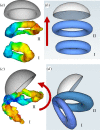Control of vortex rings for manoeuvrability
- PMID: 26136226
- PMCID: PMC4528605
- DOI: 10.1098/rsif.2015.0389
Control of vortex rings for manoeuvrability
Abstract
Manoeuvrability is critical to the success of many species. Selective forces acting over millions of years have resulted in a range of capabilities currently unmatched by machines. Thus, understanding animal control of fluids for manoeuvring has both biological and engineering applications. Within inertial fluid regimes, propulsion involves the formation and interaction of vortices to generate thrust. We use both volumetric and planar imaging techniques to quantify how jellyfish (Aurelia aurita) modulate vortex rings during turning behaviour. Our results show that these animals distort individual vortex rings during turns to alter the force balance across the animal, primarily through kinematic modulation of the bell margin. We find that only a portion of the vortex ring separates from the body during turns, which may increase torque. Using a fluorescent actin staining method, we demonstrate the presence of radial muscle fibres lining the bell along the margin. The presence of radial muscles provides a mechanistic explanation for the ability of scyphomedusae to alter their bell kinematics to generate non-symmetric thrust for manoeuvring. These results illustrate the advantage of combining imaging methods and provide new insights into the modulation and control of vorticity for low-speed animal manoeuvring.
Keywords: jellyfish; manoeuvrability; position control; swimming; vortex ring.
© 2015 The Author(s) Published by the Royal Society. All rights reserved.
Figures





References
-
- Rakow KC, Graham WM. 2006. Orientation and swimming mechanics by the scyphomedusa Aurelia sp. in shear flow. Limnol. Oceanogr. 51, 1097–1106. (10.4319/lo.2006.51.2.1097) - DOI
-
- Murphy AJ, Haroutunian M. 2011. Using bio-inspiration to improve capabilities of underwater vehicles. In Proc. 17th Int. Symp. on Unmanned Untethered Submersible Technology (UUST), Portsmouth, NH, 21–24 August 2011, pp. 20–31. Lee, NH: Autonomous Undersea Systems Institute (AUSI)/Curran Associates, Inc.
-
- Epps BP, Techet AH. 2007. Impulse generated during unsteady maneuvering of swimming fish. Exp. Fluids 43, 691–700. (10.1007/s00348-007-0401-4) - DOI
-
- Demont ME, Gosline JM. 1988. Mechanics of jet propulsion in the hydromedusan jellyfish, Polyorchis pexicillatus III. A natural resonating bell; the presence and importance of a resonant phenomenon in the locomotor structure. J. Exp. Biol. 134, 347–361.
Publication types
MeSH terms
LinkOut - more resources
Full Text Sources
Other Literature Sources
